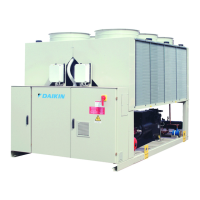) is used to allow the start of another
computer or the stop of a running one. It is required to define the proportional band and the derivative time of the PD
control, together with the pulse duration and a minimum and maximum value for pulses interval.
The minimum pulse interval is applied when the maximum correction action is required, while the maximum interval is
applied when the minimum correction action is required. A dead band is introduced to allow to reach a stable compressor
condition. Fig. 12 shows the proportional action of the controller as a function of the input parameters.
The proportional gain of the PD controller is given by:
where T
d
is the input derivative time.
In addition to the specialized PID controller, a max pull-down-rate is introduced in the control; this meanings that if the
controlled temperature is approaching the setpoint with a rate greater than a set value, any loading action is inhibited, even
if require by the PID algorithm. This makes the control slower but allows to avoid oscillations around setpoint. The controller
is designed to act both as a “chiller” and as a “heat pump”; when the “chiller” option is selected the controller will load t he
compressor if the measured temperature is above the setpoint and will unload the compressor if the measured temperature
is below the setpoint. When the “heat pump” option is selected the controller will load the compressor if the measured
temperature is below the setpoint and will unload the compressor if the measured temperature is above the setpoint. The
starting sequence of compressors is selected on the base of lower working hours amount (it means that the first compressor
that is started is the one with the lower amount of working hour); between two compressors with the same operating hours,
the compressor with minimum number of starts will start first. A manual sequencing of compressors is possible. The start
of the first compressor is allowed only if the absolute value of difference between the measured temperature and the
setpoint exceeds a Startup T value. The stop of the last compressor is allowed only if the absolute value of the difference
between the measured temperature and the setpoint exceeds a Shutdown T value.
A FILO (First In - Last Off) logic is adopted.
The start/loading and unloading/stop sequence will follow the schemes in table 2 and table 3, where RDT is the
Reload/Reunload T, a set value (that represent the minimum difference between the evaporator leaving water
temperature and its setpoint) that will a running compressor to be reload when a compressor is shutdown or a running
compressor to be unload when a new compressor is started.
This is made to keep the unit total capacity at the same level when the evaporator leaving water temperature is close to
the setpoint and a compressor stops, or another compressor starts, is required.
In Ice mode, while the compressor loading is not affected, the compressors downloading is inhibited. When downloading
is required compressors are shutdown on the basis of the evaporator leaving water temperature. In particular, said Stp the
evaporator leaving temperature setpoint, SDT the shutdown T value and n the number of compressors, the scheme in
table 6 is used. In addition when the heat pump option is installed, the compressor could be managed using a variable
speed driver (inverter). An analog output of pCO
3
board is used to control the compressor speed with a 0-10V signal. Load
management will still determine the time distance between load/unload pulses where pulse in this case means relative
variation of the output voltage. The magnitude of the variation could be adjusted under manufacturer password.
When the unit is working in heating mode the maximum speed will be the nominal speed (default value 67Hz).
When the unit is working in cooling mode an overboost option (activated either with the digital input 2 on the expansion
board #2 or automatically if the outside ambient temperature is greater than 35°C and disabled when it falls below 34°C)
is managed. It allows the compressor to run at its full speed of 90Hz if the maximum available capacity is reached. When
the overboost is disabled the valve opening (if the electronic expansion valve).

